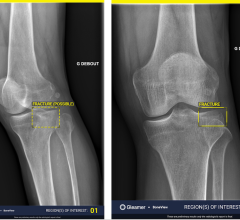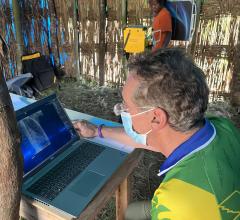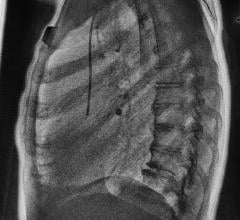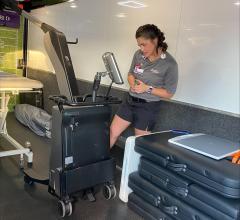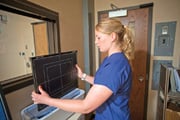
Beth Israel Deaconess Medical Center in Boston uses a Carestream wireless DR system to help manage its high volume of trauma patients.
Wireless digital radiography (DR) is at the crest of the latest wave of radiology technology. It has a variety of uses, including in the operating room and trauma units, and with bariatric as well as pediatric patients. Users are seeing distinct advantages in going with wireless DR, including portability, sterility, speed and lower radiation dose on patients, with no loss of image quality.
Jim Bates is the director of imaging services at the NCH Healthcare System in Naples, Fla., and both of the hospitals he oversees adopted wireless DR about seven years ago. He calls his hospitals some of the “early adapters,” saying they had realized that a digital format would offer huge benefits to their system.
“It was all analog and old equipment. It was labor-intensive, requiring lots of staff, film and rooms, so we are starting moving toward the digital world,” Bates said.
NCH made a short foray into computed radiography (CR), but Bates said he pushed for the move into DR as soon as possible.
“The advantages of DR were apparent overnight,” he said. “We reduced the number of full-time employees and our speed improved – we were no longer the hospital bottleneck.”
The only downside to this phase was that they were still using tethered plates, in which a cable ran from the X-ray table to the plate. Bates said they had such a good experience with the plates they had been using, made by Canon, that when Canon offered wireless, it was a natural progression for them.
“Canon asked us if we wanted to test the wireless plates and we jumped at the chance,” Bates said.
His staff had a good experience with the test plates. Seventeen of his radiologists provided feedback on the original test plates to Canon’s engineers in Japan.
“Whatever my radiologists said to Canon’s engineers, they nailed it [with the second wave of plates],” Bates said. “We couldn’t be happier with them.”
Benefits for Staff, Patients in the Emergency Room
Beth Israel Deaconess Medical Center (BIDMC) in Boston, Mass., is another hospital whose staff saw an advantage moving to an untethered wireless DR system because of their high volume of trauma patients.
Elizabeth Grady, the diagnostic radiology manager at BIDMC, uses Carestream’s wireless DR systems in the emergency room (ER), which is a level-one trauma center.
“The wireless systems we had seen before were tethered, which wouldn’t work well in a trauma unit,” Grady said. “When a trauma patient comes into an X-ray room, physicians, nurses and lots of other staff are with the patient; if you have a tether, people are tripping over it and body fluids are being spilled on it.”
Beth Israel Deaconess was able to work with a Carestream system as a demo, and the techs could see how well the tetherless system worked in a trauma center, Grady said.
“For me, it was nice that the techs were able to have a good assessment and input into the selection of the equipment [and system they chose],” Grady said. “They have to live with it more than me.”
The hospital installed the first wireless room about two to three months ago and a second one about three to four weeks ago. Grady said her techs are happy with the results.
“Wireless works much the same way the techs are trained, so the transition feels seamless from what they learn in school and positioning,” Grady said. “Where you put a cassette to where you put a detector [is similar] and they don’t feel like they’re relearning everything.”
In addition to ease of use for the tech, the system benefits the patient because the average time of an exam drops and staff members are able to move patients through an emergency area more quickly, but without sacrificing image quality, Grady said. In fact, different settings allow the same image to be viewed in different ways.
“On a portable Carestream detector, the ‘companion’ setting uses a different algorithm to look at the original image to catch hardware versus anatomy,” Grady said. An example would be a patient who had a previous spine surgery and has a metal affixation in the spine; this is especially handy for an operating room surgeon to know, she said.
Wireless DR Saves Critical Time
The radiology department at Sanford Health in Sioux Falls, S.D., uses Konica Minolta’s wireless DR system. Greg Zerfas, the supervisor of radiology at Sanford, said they had previously used other vendors with CR, but when their IT department set up a demonstration with Konica Minolta’s wireless DR, they decided to switch.
“The demonstration opened our eyes,” Zerfas said. “Our workflow improved, exposure values went down and image quality went up.”
Sanford had been looking at a DR solution for the ER, Zerfas said, but didn’t want to buy a new DR room. Gale Wynia, Sanford’s director of radiology, and Zerfas had mentioned to Konica Minolta that they would be moving to DR and the company’s sales reps told them about the wireless DR plates. They looked at the wireless plates and were “very impressed,” Zerafas said.
“The techs have really embraced wireless DR and want it everywhere,” he added. Lindsey Nyhus, the lead tech in the radiology department at Sanford, said the wireless saves time.
“Taking X-rays with a wireless saves a few minutes,” Nyhus said. “We don’t have to lug heavy films around and label them and make sure we’re not double-exposing them and having someone run them back to the readers – we just take them.”
Physicians also are able to view the digital X-rays immediately on a screen instead of waiting for film to develop, which is essential for trauma patients and critical patients.
“[The other night] in a trauma unit we had a pelvic fracture,” Nyhus said. “The trauma doctor was waiting there to see it and could see it immediately. If we had CR, they wouldn’t have even developed the X-ray by the time the doctor was telling the patient she had the fracture and was getting her right to a CT scan.”
As far as improvements with wireless DR systems in general, Wynia said that augmenting the distance a plate can connect with a receptor would be a plus.
“Increasing the distance you can take a cassette with a single receptor would be an enhancement,” he said. “We are limited right now by the distance we can go with a plate.”
SIDEBAR:
Fujifilm Receives 510(k) for its Wireless DR
Fujifilm offers a wireless digital radiography (DR) system, the FDR D-EVO, which received 510(k) clearance from the U.S. Food and Drug Administration (FDA) in May. It features the company’s patented Irradiation Side Sampling (ISS), a technology to improve detective quantum efficiency (DQE) and enable technologists to take high-quality images at lower doses. This design reduces scatter and blur of X-rays captured, resulting in sharper images with greater detail.
The FDR D-EVO wireless also offers a lasting power supply. A lightweight removable lithium ion battery provides fast charge times and up to three hours or 400 exposures of use per charge. A multi-charger system with two spare batteries is included with the detector. Additionally, a detachable cord provides the option for continuous charging and the ability to leave the detector in the Bucky for uninterrupted extended use.

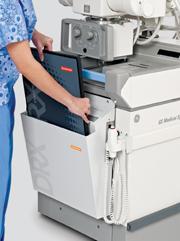

 December 10, 2025
December 10, 2025 


